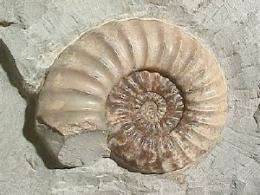December 3, 2010 report
Ammonites were probably eaten by fellow cephalopods

(Â鶹ÒùÔºOrg.com) -- Fossilized ammonites found with bite marks in similar places on their shells suggest they were eaten by other cephalopods such as beaked squid, according to new research published in the Proceedings of the Yorkshire Geological Society.
The ammonites were invertebrate marine creatures living in shallow waters less than 100 meters deep. They became extinct around the end of the Cretaceous period, and are thought to be the ancestors of the modern-day cephalopods, which include squid, cuttlefish, nautilus and octopus species. They are the best preserved and most widely found fossil around the world, and are recognizable by their spiral shells. They were predators themselves, feeding on a variety of fish, mollusks, and even other cephalopods, but little is known about ammonites as prey.
Around a fifth of the ammonite fossils found on the Jurassic Coast in Dorset in the UK have what appear to be bite marks in an area near the back of the shell where muscles would have held the shell in place. A bite at this point would have severed the muscles and allowed the body to be drawn out of the shell.
Any predator producing the bite marks would need to have been precise, and must have been capable of grabbing hold of the ammonite and manipulating it into the right position for the kill. One of the authors of the paper, Paddy Howe, a geologist with the Lyme Regis Museum, said modern cephalopods are perfectly capable of the kind of adept behavior required, and a beaked squid could certainly be the culprit, since the bite marks are consistent with a beak.
Another possibility is a gas bubble between the body and the shell, but as Richard Edmonds of the Jurassic Coast World Heritage Site points out, this is a much less likely explanation. Depressions made in this way would be expected to contain crushed shell, but Mr Edmonds said he had never seen a fossil like that. Shell fragments would also be expected if the marks were made after the animal had died, and the marks would not all be in the same place on the shell.
The Jurassic Coast World Heritage Site covers over 150 kilometers of coastline in the UK counties of Dorset and East Devon, and is an area well-known for ammonite fossils and many other fossils from the Triassic, Jurassic and Cretaceous geological periods.
More information: Fatally bitten ammonites from the lower Lias Group (Lower Jurassic) of Lyme Regis, Dorset, by Chris Andrew et al. Proceedings of the Yorkshire Geological Society , 58, 81-94. doi:10.1144/​pygs.58.1.276
© 2010 Â鶹ÒùÔºOrg.com




















